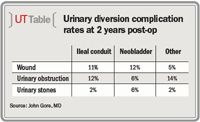News
Article
Incidence of late post-diversion complications is high
Complications after urinary diversion occur often and continue to occur for at least 5 years after surgery.
Key Points

Wound problems and urinary obstruction were among the most common late complications. Five years after surgery, one-third of patients with neobladders had wound complications, and almost 20% of patients who had other types of diversion procedures had wound complications. About 15% of patients had urinary obstruction, regardless of the type of procedure.
"There is a substantial risk of delayed wound complications, issues with urinary obstruction, issues with stone disease, that are more pronounced than people potentially acknowledge," said first author John Gore, MD, assistant professor of urology at the University of Washington, Seattle. "Some of these long-term consequences of the diversion are subjugated in importance to some of the immediate concerns."
Dr. Gore and co-author Scott Gilbert, MD, assistant professor of urology at the University of Florida, Gainesville, undertook an analysis aimed at characterizing long-term complications of urinary diversion and associated health care utilization. The study was conducted as part of the Urologic Diseases in America project.
Using a 5% sample of Medicare claims data from 1997-2007, investigators identified patients who underwent neobladder procedures, ileal conduit urinary diversion, and other urinary diversion procedures. The search was limited to patients who had claims data for 1 year prior to surgery and at least 2 years afterward. Benign and malignant primary diagnoses were included.
For health care utilization analyses, urinary diversion patients were compared with patients treated for bladder cancer without cystectomy and diversion and patients who underwent colectomy.
The search identified 1,565 patients who had urinary diversion procedures, 80% of which were ileal conduit urinary diversions. Another 7% underwent cutaneous or orthotopic neobladder procedures, and 13% had other types of reconstruction, including bladder augmentation.
At 2 years, patients who underwent ileal conduit and neobladder procedures had wound complication rates of 11% and 12%, respectively, compared with 5% for patients who had other types of reconstruction procedures (p=.03). Urinary obstruction occurred in 12% of ileal conduit patients, 14% of patients who had other procedures, and 6% of the neobladder group. Patients with neobladders had a 6% incidence of urinary stones compared with 2% in both the ileal and other groups (p=.02).
Other complications noted at 2 years included infections (1% to 2% across the three groups), stomal complications (3% to 4%), incisional hernias (4% to 6%), and fistulae (3% to 5%).
Complications still seen at 5 years
The 5-year analysis comprised 694 of the original patients, and the proportion in each surgical group was similar. The data showed that 34% of neobladder patients had wound complications, as did 19% of the ileal conduit group and 18% of the patients who had other procedures (p=.02). The neobladder patients had a 13% incidence of urinary stones compared with 4% in the other two groups (p=.01). Fistula formation also was significantly more common in the neobladder group (11% vs. 4% for the ileal group and 7% for other types of reconstruction, p=.03).
Rates of urinary obstruction (13% to 17%), infection (2% to 4%), stomal complications (6% to 9%), and hernia (10% to 14%) did not differ significantly among the groups.
In comparison to the non-cystectomy bladder cancer and colectomy cohorts, the urinary diversion population had significantly more hospital admissions in years 1 and 2 (p<.001) and more emergency room visits in the 24 months after surgery (p<.001).
"The principal message to take away from this study is that it's important to be cognizant of these complications and think about quality of care," Dr. Gore told Urology Times. "When you think about following these patients, you have to think about cancer surveillance but also about reconstruction surveillance. These downstream issues of urinary diversion are significant, and we need to be mindful of the possible risks of these when thinking about how to follow these patients."
ModernMedicine NETWORK
















